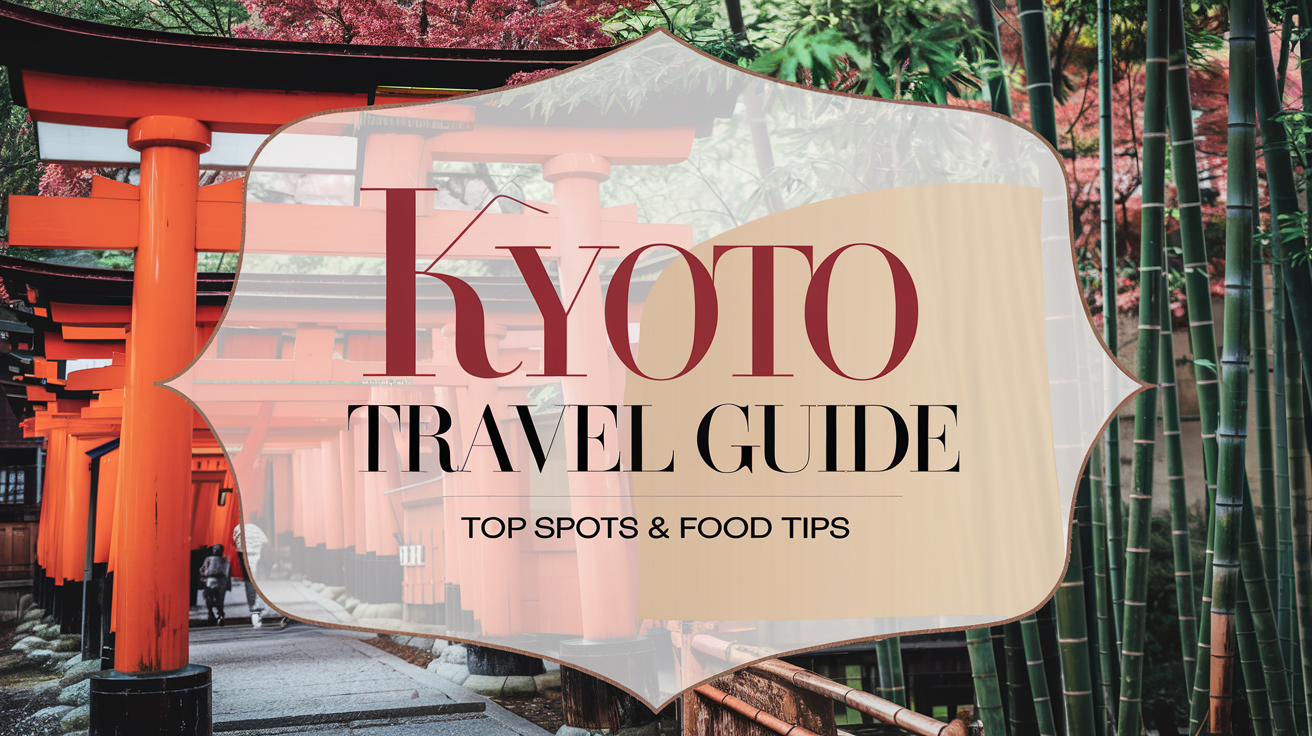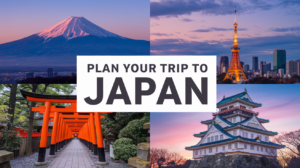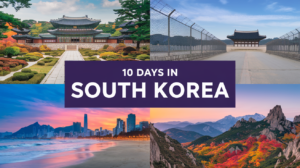Kyoto, the cultural heart of Japan, is a city steeped in tradition, history, and breathtaking beauty. With its ancient temples, serene gardens, and iconic landmarks, Kyoto offers an unforgettable experience for every traveler. Here’s the first part of our guide to Kyoto’s top 20 attractions, complete with all the information you need to plan your visit.
1. Fushimi Inari Taisha
Description: Famous for its thousands of vermilion torii gates, Fushimi Inari Taisha is a Shinto shrine dedicated to Inari, the deity of rice and prosperity. The pathways through the gates lead to Mount Inari, offering stunning views.
History: Founded in 711 AD, Fushimi Inari Taisha is one of the oldest and most significant Shinto shrines in Japan. The torii gates are donated by individuals and businesses seeking blessings for success.
Google Maps Link: Fushimi Inari Taisha
Official Website: Fushimi Inari Taisha
Ticket Prices: Free entry.
Opening Hours: Open 24 hours.
Travel Options:
– By train: JR Inari Station (JR Nara Line) or Fushimi-Inari Station (Keihan Line).
Nearby Restaurants:
– Ramen Hiwamata Noboru – Known for its rich and flavorful ramen.
– Kichi Kichi Omurice – Famous for its fluffy Japanese omelet rice.
Additional Tips: Visit early in the morning or late afternoon to avoid crowds. Wear comfortable shoes if you plan to hike up Mount Inari.
2. Kinkaku-ji (Golden Pavilion)
Description: A Zen Buddhist temple covered in stunning gold leaf, Kinkaku-ji is surrounded by a tranquil pond and lush gardens, making it one of Kyoto’s most iconic sights.
History: Originally built as a retirement villa in 1397 by Shogun Ashikaga Yoshimitsu, it was converted into a temple after his death. The current structure dates back to 1955 after a fire destroyed the original.
Google Maps Link: Kinkaku-ji
Official Website: Kinkaku-ji
Ticket Prices: ¥400 (approx. $3 USD).
Opening Hours: 9:00 am – 5:00 pm daily.
Travel Options:
– By bus: Kyoto City Bus #101 or #205 to Kinkakuji-michi bus stop.
Nearby Restaurants:
– Shishin Samurai Café & Bar – Offers traditional Kyoto cuisine and sake.
– Nishijin Uoshin – Known for its fresh seafood dishes.
Additional Tips: Visit on a clear day for the best reflections of the Golden Pavilion in the surrounding pond.
3. Arashiyama Bamboo Grove
Description: A serene forest path lined with towering bamboo stalks, the Arashiyama Bamboo Grove is one of Kyoto’s most photographed spots, offering a unique and tranquil atmosphere.
History: The bamboo grove has been part of Kyoto’s cultural landscape for centuries and is located near Tenryu-ji, a UNESCO World Heritage Site.
Google Maps Link: Arashiyama Bamboo Grove
Ticket Prices: Free entry.
Opening Hours: Open 24 hours.
Travel Options:
– By train: JR Saga-Arashiyama Station or Hankyu Arashiyama Station.
Nearby Restaurants:
– Shoraian – Specializes in tofu dishes with stunning views of the river.
– Arashiyama Yoshimura – Offers delicious soba noodles.
Additional Tips: Visit early in the morning for fewer crowds. Combine your visit with nearby attractions like Tenryu-ji Temple and the Togetsukyo Bridge.
4. Gion District
Description: Kyoto’s historic geisha district, Gion is known for its traditional wooden machiya houses, tea houses, and cultural performances. It’s a great place to experience Kyoto’s old-world charm.
History: Gion dates back to the 17th century when it developed around the Yasaka Shrine. It remains a center of Kyoto’s cultural heritage and geisha traditions.
Google Maps Link: Gion District
Ticket Prices: Free to explore; costs vary for tea house experiences.
Opening Hours: Open 24 hours; performances and shops have individual hours.
Travel Options:
– By bus: Kyoto City Bus #100 or #206 to Gion bus stop.
Nearby Restaurants:
– Gion Karyo – Offers traditional kaiseki cuisine in a refined setting.
– Yasaka Endo – Famous for its Kyoto-style sushi and tempura.
Additional Tips: Visit in the evening for a chance to spot a geisha or maiko walking to their appointments. Don’t miss the illuminated streets during festivals.
5. Nijo Castle
Description: A historic castle featuring beautiful gardens, impressive architecture, and the famous “nightingale floors,” which chirp when walked on to prevent stealthy intrusions.
History: Built in 1603 as the residence of Tokugawa Ieyasu, the first shogun of the Edo Period, Nijo Castle showcases the power and culture of the shogunate era.
Google Maps Link: Nijo Castle
Official Website: Nijo Castle
Ticket Prices: ¥800 (approx. $6 USD).
Opening Hours: 8:45 am – 5:00 pm (last entry at 4:00 pm).
Travel Options:
– By subway: Nijojo-mae Station (Tozai Line).
Nearby Restaurants:
– Nijo Wakasaya – Known for its Kyoto-style sweets and green tea.
– Menbaka Fire Ramen – Famous for its dramatic flame-seared ramen.
Additional Tips: Rent an audio guide for a deeper understanding of the castle’s history. Visit in spring to see the cherry blossoms in the castle gardens.
Travel Tips:
Best Time to Visit: Spring (March-April) and autumn (November) offer ideal weather and stunning scenery. Cherry blossoms and fall foliage enhance the beauty of Kyoto’s landmarks.
Transportation: Kyoto’s public transportation, including buses and trains, is efficient. A Kyoto City Bus Pass or prepaid IC card like ICOCA is recommended for hassle-free travel.
Local Cuisine to Try: Sample kaiseki meals, matcha sweets, and Kyoto-style sushi near the attractions.
6. Philosopher’s Path (Tetsugaku no Michi)
Description: A scenic walking path lined with cherry trees, small temples, and charming cafes, the Philosopher’s Path follows a canal in Kyoto’s Higashiyama district. It’s a peaceful spot for reflection and nature walks.
History: Named after Nishida Kitaro, a famous Japanese philosopher who walked this path daily for meditation, it became a beloved spot for locals and visitors alike.
Google Maps Link: Philosopher’s Path
Ticket Prices: Free entry.
Opening Hours: Open 24 hours.
Travel Options:
– By bus: Kyoto City Bus #100 or #204 to Ginkakuji-michi bus stop.
Nearby Restaurants:
– Yojiya Café – Offers matcha-based drinks and desserts in a traditional setting.
– Omen Ginkakuji – Famous for its handmade udon noodles.
Additional Tips: Visit during cherry blossom season (late March to early April) for breathtaking scenery. The path is also beautiful in autumn with vibrant foliage.
7. Tofuku-ji Temple
Description: A Zen temple known for its stunning gardens, wooden bridges, and vibrant autumn leaves, Tofuku-ji is one of Kyoto’s most important cultural landmarks.
History: Established in 1236, Tofuku-ji is the head temple of the Tofuku school of Rinzai Zen Buddhism. It’s famous for its Hojo gardens, designed in the 14th century.
Google Maps Link: Tofuku-ji Temple
Official Website: Tofuku-ji Temple
Ticket Prices:
– Temple grounds: Free.
– Hojo gardens and Tsutenkyo Bridge: ¥400 (approx. $3 USD).
Opening Hours: 9:00 am – 4:00 pm daily.
Travel Options:
– By train: Tofukuji Station (JR Nara Line or Keihan Line).
Nearby Restaurants:
– Cafe Arabica Kyoto Higashiyama – Offers excellent coffee and pastries.
– Izusen – Serves traditional Buddhist vegetarian cuisine.
Additional Tips: Visit in November for spectacular autumn colors. Arrive early to avoid crowds during peak foliage season.
8. Kiyomizu-dera Temple
Description: One of Kyoto’s most famous temples, Kiyomizu-dera offers stunning views of the city from its wooden stage, as well as beautiful gardens and historical significance.
History: Founded in 778, Kiyomizu-dera is a UNESCO World Heritage Site and has been a place of worship for over 1,200 years. Its name means “Pure Water Temple,” derived from the Otowa Waterfall on the grounds.
Google Maps Link: Kiyomizu-dera Temple
Official Website: Kiyomizu-dera Temple
Ticket Prices: ¥400 (approx. $3 USD).
Opening Hours: 6:00 am – 6:00 pm daily (extended hours during special events).
Travel Options:
– By bus: Kyoto City Bus #100 or #206 to Gojozaka or Kiyomizu-michi bus stop.
Nearby Restaurants:
– Kaiseki Mizuki – Offers refined Japanese multi-course meals.
– Yoshimura Kiyomizuan – Known for its soba noodles with a view of Kyoto.
Additional Tips: Visit early in the morning or late afternoon for fewer crowds. The temple is illuminated during spring and autumn evenings.
9. Nanzen-ji Temple
Description: A Zen temple with a massive Sanmon gate, picturesque gardens, and the unique Suirokaku aqueduct, Nanzen-ji is a peaceful retreat with historical charm.
History: Established in 1291, Nanzen-ji is one of Kyoto’s most important Zen temples and served as a retirement villa for Emperor Kameyama before becoming a temple.
Google Maps Link: Nanzen-ji Temple
Official Website: Nanzen-ji Temple
Ticket Prices:
– Grounds: Free.
– Sanmon gate and Hojo gardens: ¥500 (approx. $4 USD).
Opening Hours:
– 8:40 am – 5:00 pm (March to November).
– 8:40 am – 4:30 pm (December to February).
Travel Options:
– By subway: Keage Station (Tozai Line).
Nearby Restaurants:
– Okutan Nanzenji – Specializes in Kyoto-style tofu dishes.
– Hyotei – A Michelin-starred restaurant serving kaiseki cuisine.
Additional Tips: Explore the aqueduct and nearby trails for beautiful photo opportunities. Combine your visit with the Philosopher’s Path, which starts nearby.
10. Ryoan-ji Temple
Description: Famous for its minimalist rock garden, Ryoan-ji is a UNESCO World Heritage Site and a masterpiece of Zen landscaping. Its tranquil surroundings make it ideal for meditation.
History: Built in the 15th century, Ryoan-ji was originally an aristocrat’s villa before being converted into a Zen temple. The rock garden’s design remains a mystery, sparking contemplation and discussion.
Google Maps Link: Ryoan-ji Temple
Official Website: Ryoan-ji Temple
Ticket Prices: ¥500 (approx. $4 USD).
Opening Hours:
– 8:00 am – 5:00 pm (March to November).
– 8:30 am – 4:30 pm (December to February).
Travel Options:
– By bus: Kyoto City Bus #50 or #55 to Ritsumeikan Daigaku-mae bus stop.
Nearby Restaurants:
– Ryoanji Yudofu – Famous for its Kyoto-style boiled tofu dishes.
– Kitaro Café – Offers matcha desserts and traditional snacks.
Additional Tips: Visit in the morning for a quieter atmosphere. Pair your visit with nearby Kinkaku-ji (Golden Pavilion), just a short bus ride away.
Travel Tips:
Best Time to Visit: Spring and autumn are ideal for the Philosopher’s Path, Tofuku-ji, and Kiyomizu-dera for their cherry blossoms and fall foliage. Winter offers serene views at Nanzen-ji and Ryoan-ji.
Transportation: Use Kyoto’s efficient bus network or rent a bicycle to explore attractions close to each other, like Ryoan-ji and Kinkaku-ji.
Local Cuisine to Try: Don’t miss Kyoto-style yudofu (tofu), matcha desserts, and seasonal kaiseki meals near the temples.
11. Heian Shrine (Heian Jingu)
Description: A Shinto shrine with an impressive red torii gate, beautifully landscaped gardens, and a pond. The shrine celebrates Kyoto’s history and cultural heritage.
History: Built in 1895 to commemorate the 1,100th anniversary of Kyoto’s founding as Japan’s capital, Heian Shrine is dedicated to Emperor Kanmu and Emperor Komei.
Google Maps Link: Heian Shrine
Official Website: Heian Shrine
Ticket Prices:
– Shrine grounds: Free.
– Garden entry: ¥600 (approx. $4 USD).
Opening Hours:
– Shrine: 6:00 am – 6:00 pm.
– Garden: 8:30 am – 5:00 pm.
Travel Options:
– By bus: Kyoto City Bus #5 or #100 to Okazaki-michi bus stop.
Nearby Restaurants:
– Okariba – Offers game meat dishes and traditional Kyoto cuisine.
– Matsudaya – Known for its freshly made soba noodles.
Additional Tips: Visit during the spring cherry blossom season or October for the Jidai Matsuri (Festival of the Ages), which features historical parades.
12. Sanjusangendo Temple
Description: Famous for its 1,001 statues of Kannon, the goddess of mercy, Sanjusangendo Temple is a spiritual and architectural marvel. The long hall housing the statues is awe-inspiring.
History: Built in 1164, the temple has survived multiple reconstructions and remains a symbol of endurance and devotion in Japanese Buddhism.
Google Maps Link: Sanjusangendo Temple
Official Website: Sanjusangendo Temple
Ticket Prices: ¥600 (approx. $4 USD).
Opening Hours: 8:00 am – 5:00 pm (last entry at 4:30 pm).
Travel Options:
– By bus: Kyoto City Bus #100 or #206 to Hakubutsukan Sanjusangendo-mae bus stop.
Nearby Restaurants:
– Hyotei Annex – Specializes in Kyoto-style bento boxes.
– Ganko Kyoto Station – Known for its sushi and traditional Japanese meals.
Additional Tips: Photography is not allowed inside the hall to preserve the sacred atmosphere. Visit early to experience the temple’s serenity.
13. Ginkaku-ji (Silver Pavilion)
Description: A Zen temple renowned for its understated elegance, Ginkaku-ji features a simple yet beautiful design, stunning moss gardens, and a sand garden.
History: Built in 1482 as a retirement villa for Shogun Ashikaga Yoshimasa, it became a Zen temple after his death. Despite its name, the pavilion was never covered in silver, symbolizing Wabi-sabi (beauty in imperfection).
Google Maps Link: Ginkaku-ji Temple
Official Website: Ginkaku-ji Temple
Ticket Prices: ¥500 (approx. $4 USD).
Opening Hours: 8:30 am – 5:00 pm (March to November); 9:00 am – 4:30 pm (December to February).
Travel Options:
– By bus: Kyoto City Bus #100 or #204 to Ginkakuji-michi bus stop.
Nearby Restaurants:
– Ganko Ginkakuji – Offers sushi and Kyoto-style dishes.
– Wadachi – Known for its soba noodles and tempura.
Additional Tips: Combine your visit with a walk along the Philosopher’s Path, located nearby. Visit in autumn for vibrant foliage.
14. Eikan-do Temple (Zenrin-ji)
Description: A beautiful Buddhist temple set against a forested hillside, Eikan-do is renowned for its autumn foliage, elegant pagoda, and serene atmosphere.
History: Established in 863 as a Pure Land Buddhist temple, Eikan-do has become a symbol of Kyoto’s cultural and spiritual heritage.
Google Maps Link: Eikan-do Temple
Official Website: Eikan-do Temple
Ticket Prices: ¥600 (approx. $4 USD).
Opening Hours: 9:00 am – 5:00 pm (last entry at 4:00 pm).
Travel Options:
– By bus: Kyoto City Bus #5 to Nanzenji-Eikando-michi bus stop.
Nearby Restaurants:
– Okutan Nanzenji – Serves Kyoto-style tofu dishes.
– Yojiya Café Ginkakuji – Offers matcha desserts and light snacks.
Additional Tips: Visit in mid to late November for spectacular autumn colors. The evening illuminations are a must-see during fall.
15. Fushimi Sake District
Description: A historic district south of Kyoto famous for its sake breweries, charming canals, and traditional townscape. Visitors can enjoy sake tasting, brewery tours, and riverboat rides.
History: With pure spring water and a favorable climate, Fushimi has been a hub for sake brewing since the Edo period. It remains one of Japan’s top sake-producing regions.
Google Maps Link: Fushimi Sake District
Official Website: Gekkeikan Okura Sake Museum
Ticket Prices:
– Gekkeikan Okura Sake Museum: ¥600 (approx. $4 USD), includes sake tasting.
Opening Hours:
– Sake Museum: 9:30 am – 4:30 pm (last entry at 4:00 pm).
Travel Options:
– By train: Chushojima Station (Keihan Line) or Momoyama Station (JR Nara Line).
Nearby Restaurants:
– Torisei Fushimi – Known for its yakitori and sake pairings.
– Choken – Offers Kyoto-style sushi and traditional dishes.
Additional Tips: Take a riverboat ride along the canals for a unique perspective of the district. Don’t forget to bring home some sake as a souvenir!
Travel Tips:
Best Time to Visit: Autumn (November) is ideal for Eikan-do and Heian Shrine gardens, while the Fushimi Sake District is enjoyable year-round for sake enthusiasts.
Transportation: Kyoto’s efficient public transport system connects all attractions easily. Consider a Kansai Thru Pass if you plan to explore beyond Kyoto.
Local Cuisine to Try: Pair Kyoto’s sake with yakitori in Fushimi, enjoy matcha desserts near Eikan-do, and try fresh soba noodles at Ginkaku-ji.
16. Kyoto Imperial Palace (Kyoto Gosho)
Description: Once the residence of Japan’s imperial family, the Kyoto Imperial Palace is a majestic complex featuring traditional Japanese architecture, manicured gardens, and a glimpse into imperial history.
History: The palace served as the imperial residence until the capital moved to Tokyo in 1869. The current structure was reconstructed in 1855 after multiple fires.
Google Maps Link: Kyoto Imperial Palace
Official Website: Kyoto Imperial Palace
Ticket Prices: Free entry (advance reservation recommended).
Opening Hours: 9:00 am – 5:00 pm (last entry at 4:20 pm).
Travel Options:
– By subway: Imadegawa Station (Karasuma Line).
Nearby Restaurants:
– Ganko Takasegawa Nijoen – Offers Kyoto-style kaiseki meals in a historic setting.
– Omen Kyoto – Known for its handmade udon noodles and tempura.
Additional Tips: Guided tours are available in English. Visit the adjacent Kyoto Gyoen National Garden for a peaceful stroll.
17. Pontocho Alley
Description: A narrow, atmospheric alley along the Kamogawa River, Pontocho is lined with traditional tea houses, restaurants, and bars. It’s one of Kyoto’s best spots for evening dining and entertainment.
History: Pontocho has been a center for Kyoto’s nightlife and traditional geisha culture since the Edo period. Many establishments here have a history spanning generations.
Google Maps Link: Pontocho Alley
Ticket Prices: Free to explore; dining costs vary.
Opening Hours: Open 24 hours; restaurants and bars typically operate from 5:00 pm – 11:00 pm.
Travel Options:
– By subway: Sanjo Station (Keihan Line).
Nearby Restaurants:
– Kaiseki Mizuki – Renowned for multi-course Japanese dining with river views.
– Pontocho Kappa Zushi – Offers affordable sushi in a casual setting.
Additional Tips: Visit in the evening for the best atmosphere. During summer, many restaurants set up outdoor seating along the river for a unique dining experience.
18. Daigo-ji Temple
Description: A sprawling temple complex known for its beautiful pagoda, scenic gardens, and seasonal cherry blossoms and autumn foliage. Daigo-ji is a UNESCO World Heritage Site.
History: Founded in 874 by the monk Shobo, Daigo-ji has long been a center of Shingon Buddhism. The five-story pagoda, built in 951, is Kyoto’s oldest surviving wooden structure.
Google Maps Link: Daigo-ji Temple
Official Website: Daigo-ji Temple
Ticket Prices: ¥800 (approx. $6 USD).
Opening Hours: 9:00 am – 5:00 pm (March to November); 9:00 am – 4:30 pm (December to February).
Travel Options:
– By train: Daigo Station (Tozai Line).
Nearby Restaurants:
– Daigo Saryo – Specializes in Buddhist vegetarian cuisine.
– Ichijikusho – Known for its seasonal Kyoto-style sweets.
Additional Tips: Visit in spring (late March to early April) for cherry blossoms or late November for autumn colors. Allocate at least two hours to explore the temple grounds fully.
19. Nishiki Market
Description: Known as “Kyoto’s Kitchen,” Nishiki Market is a bustling, five-block-long shopping street filled with fresh seafood, pickles, traditional sweets, and local delicacies.
History: The market dates back over 400 years and has been a vital center for Kyoto’s culinary culture. Today, it blends history with a modern foodie vibe.
Google Maps Link: Nishiki Market
Ticket Prices: Free entry; food prices vary by vendor.
Opening Hours: 9:00 am – 6:00 pm (hours vary by shop).
Travel Options:
– By subway: Shijo Station (Karasuma Line) or Karasuma Station.
Nearby Restaurants:
– Nishiki Warai – Known for its Kyoto-style okonomiyaki.
– Yuba Restaurant Higashiyama – Offers fresh yuba (tofu skin) dishes.
Additional Tips: Visit mid-morning to avoid crowds. Bring cash for small vendors, as many don’t accept cards.
20. Toji Temple
Description: Famous for its five-story pagoda, Toji Temple is a UNESCO World Heritage Site and a symbol of Kyoto. It features a beautiful garden and impressive Buddhist statues.
History: Established in 794 during Kyoto’s founding as the capital, Toji is one of the oldest temples in Japan and has served as a center of esoteric Shingon Buddhism.
Google Maps Link: Toji Temple
Official Website: Toji Temple
Ticket Prices:
– Temple grounds: ¥500 (approx. $4 USD).
– Special exhibitions may require additional fees.
Opening Hours: 8:30 am – 5:30 pm (last entry at 5:00 pm).
Travel Options:
– By train: Toji Station (Kintetsu Line) or Kyoto Station (a 15-minute walk).
Nearby Restaurants:
– Kyoto Ramen Koji (at Kyoto Station) – Features ramen shops from across Japan.
– Wajouryoumen Sugari – Known for its tsukemen (dipping noodles).
Additional Tips: Visit during the monthly flea market on the 21st for unique souvenirs and local goods. The temple is especially stunning during seasonal illuminations.
Travel Tips:
Best Time to Visit: Spring and autumn are perfect for Daigo-ji Temple and Kyoto Imperial Palace gardens. Nishiki Market is vibrant year-round, and Pontocho Alley comes alive in the evenings.
Transportation: Use Kyoto’s subway and bus systems to navigate efficiently. Consider a Kyoto City Bus Pass for unlimited rides.
Local Cuisine to Try: Sample fresh yuba, Kyoto-style okonomiyaki, and seasonal kaiseki meals near these attractions.




